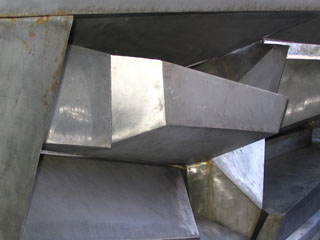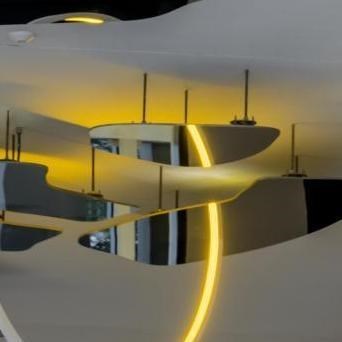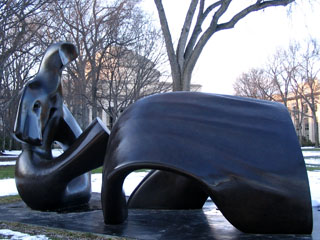Introduction
This cache will take you on a small tour of the MIT campus. It will certainly exercise your research ability, not your physical ability. There are no rope bridges to cross, nor even piles of rocks or brush to move to get to the cache. Indeed, the cache itself is not even hidden. The entire tour was designed so that it could be solved by a person in a wheelchair, although such a person may need an assistant to retrieve the cache and there may be a fair bit of (level) ground to travel.  This cache should be solvable during the winter unless there is an enormous amount of snow. If there is less than two feet you should be fine. (However, a person in a wheelchair may not be able to see the cache due to snow cover.) This is a micro cache. Consequently, please do not leave any items in the cache (with the exception of Geocoins I guess) and please don’t expect to find anything in the cache. You must sign the logbook, make a log entry, and email a description of the cache to log this one.
This cache should be solvable during the winter unless there is an enormous amount of snow. If there is less than two feet you should be fine. (However, a person in a wheelchair may not be able to see the cache due to snow cover.) This is a micro cache. Consequently, please do not leave any items in the cache (with the exception of Geocoins I guess) and please don’t expect to find anything in the cache. You must sign the logbook, make a log entry, and email a description of the cache to log this one.
Parking
You may find parking near 42 21.531N 071 05.858W. If not, just drive around a lot, there is parking in Cambridge, you just have to find it. Much of the parking in Cambridge is by resident permit only, read the signs. The #1 MBTA bus stops right in front of MIT on Mass Ave and the Red Line stops at the MIT/Kendall station. Of course, there are bikes parked everywhere you look, just be sure to bring a good lock or it might not be there when you get back! And if you must drive, bring some quarters for the meters.
First, A Bit About MIT's History and Its Relationship to the Arts
MIT is not entirely a technology school. In addition to Engineering and Science Schools, MIT has a School of Humanities, Arts and Social Sciences. Students take a smattering of classes exploring both the breadth and depth of the various subjects, and it is even possible to get a degree from MIT in "Course 21," a non-science field.
This has been the case for a while now. When MIT first admitted students in 1865, the requirements for admission were broad. An applicant needed to not only demonstrate good training in arithmetic, algebra, geometry, but also in English grammar, geography, and the rudiments of French! A typical entrance exam was just as broad, featuring questions such as:
- Extract the cube root of 39.304 to three decimal places.
- Give your idea of the character and conduct of Washington as a military man.
- Give reasons for or against the adoption of the modern word telegram.
MIT has always had an interest in the arts and this is certainly shown in the amount of public art on campus. And if you don't have an interest in the arts, just skip the next three sections, you don't need to read the next two sections to solve the cache.
 |
|
Jean-Robert Ipoustéguy
Cenotapha
1957 |
|
| |
Jean-Robert Ipoustéguy
Jean-Robert Ipoustéguy was born in France in 1920. He is a sculptor, painter and writer. Since his family name (Robert) was too much common in France, he decided to take his mother's maiden name - Ipoustéguy - as his artist name.
Ipoustéguy studied painting from 1938 to 1947 under Robert Lesbounit in Paris. In 1953, he turned to sculpture and in 1956 received the encouragement of sculptor Henri-Georges Adams, who invited him to exhibit in the Salon de Mai art show in Paris. Adams' influence is obvious in works like the Rose (1955) or the Cenotapha (1957).
But Ipoustéguy quickly moved away from this purity of volumes to lead to his abrupt, powerful and tormented style. He pursued his research with various materials as he moved from strongly abstract forms to constructions incorporating human figures in posed or simple everyday positions. Dislocated parts regrouped into monumental compositions are a recurring element of his work, giving his style a very personal, lyrical dimension.
His classical training as a direct carver of marble is evident in all his works. You can learn more about him on his Web page.
Olafur Eliasson
| |
 |
| |
Olafur Eliasson
Northwest Passage
1976 |
| |
Olafur Eliasson (b. 1967) was born in Copenhagen, Denmark. Eliasson’s work in sculpture, painting, photography, film, and installation has been exhibited throughout the world. In addition to creating works for museum and gallery settings, he engages the broader public through architectural projects and interventions in civic spaces.
Northwest Passage, a site-specific installation by Olafur Eliasson, spans 123 feet, consisting of half-rings of yellow LED lights hanging from, and are reflected by, clusters of polished stainless-steel panels that are attached to the ceiling. The abstract rounded forms of the panels, which vary in size, are based on the silhouettes and configurations of free-floating ice found in the Parry Channel of the Northwest Passage between North America and the Arctic Circle, a historically impassable frozen route linking the Pacific to the Atlantic through the Arctic Ocean. As of the summer of 2007, climate change accelerated the thinning of its ice such that vessels have been able to sail the passage without requiring an icebreaker, an event that scientists predict will become more and more common with the continued effects of global warming. This development is both a byproduct of global industry and a driver of intercontinental freight shipping, which further contributes to climate change.
Eliasson’s installation addresses this phenomenon at a far smaller scale. Humans and their movements through this passageway are reflected in the work, perhaps implicated as part of this consequential change, which will cause rising tides and eventually impact cities like Cambridge. The mirrored surfaces at times complete the suspended half-circles of light, which might read as setting suns, and at times fragment the reflected forms, suggesting disrupted routes or broken cycles. These optical illusions ask viewers to consider the impact of their physical position on what they see.
Henry Moore
 |
|
Henry Moore
Three-Piece Reclining Figure, Draped
1976 |
|
| |
Henry Spencer Moore (July 30, 1898-August 31, 1986) was an artist and sculptor. Born into a poor mining family in Castleford, he became well-known for his large-scale abstract cast bronze and carved marble sculptures; substantially supported by the British art establishment, Moore helped to introduce a particular strand of modernism into Britain.
His signature form is a pierced reclining figure, first influenced by a Toltec-Maya sculpture known as "Chac Mool," which he had seen as a plaster cast in Paris in 1925. Early versions are pierced conventionally as a bent arm reconnects with the body, later more abstract versions are pieced directly through the body, in order to explore the concave and convex shapes. These more extreme piercings developed in parallel with Barbara Hepworth's sculptures, when she first pierced a torso after misreading a review of one of Henry Moore's early shows.
Moore is best known for his abstract monumental bronzes which can be seen in many places around the world as public works of art. The subjects are usually abstractions of the human figure, typically mother-and-child or reclining figures. Interestingly, apart from a flirtation with family groups in the 1950s, the subject is nearly always a female figure.
When Moore's niece asked why his sculptures had such simple titles, he replied:
All art should have a certain mystery and should make demands on the spectator. Giving a sculpture or a drawing too explicit a title takes away part of that mystery so that the spectator moves on to the next object, making no effort to ponder the meaning of what he has just seen. Everyone thinks that he or she looks but they don't really, you know.
You can learn more about Henry Moore at his official Web site.
Okay, enough already, let's get started.
You start your journey at Eliasson's Northwest Passage. Remember, it is 123 feet long, so where do you take coordinates? Stand on the north side, not the south side facing the sculpture. There is a set of low steps on your left. Stand at that corner and take a good accurate reading. Now add 0.001N and 0.005W. (And frankly, you can probably skip that part, it is assuming an accuracy that doesn't really exist.)
Go to that location, bring a snack, I'm sure you'll be tired after the long walk. :- )
You are now where Ipoustéguy's Cenotapha used to be! (It is currently at Endicott House.) Next, walk directly toward Moore's Three-Piece Reclining Figure, Draped, traveling in an absolutely straight line. You may need to walk through solid walls, or at least somehow pretend to.
When you get to Three-Piece Reclining Figure, Draped, turn left 71 degrees from your previous direction of travel and walk in a straight line until you hit the river. (Note, if you take any GPS readings to accomplish this, take the ones at the Moore sculpture while standing on the sidewalk facing the work, with Heizer's Guennette visible behind it.)
Neither of these sculptures is at the coordinates listed for the cache. You do not need to visit those coordinates. You may want to use some of the features on your GPS receiver that you've not used before.
You do not need to go poking about in the brush to find the physical cache. You should be able to see it quite easily, but of course (heh heh heh) you need to be looking in the exact right place! (Remember, very deep snow will obscure the cache.) Please sign the logbook but, I'm sorry, it is small, so please don't take up too much room, bring your own pen, and let me know if the logbook is filling up.
The cache itself can be difficult to close. Please make sure the logbook is sideways, not up and down, in the container. It should close easily then.
You will either have to practice extreme stealth on nice sunny days, or be prepared to explain geocaching to others.
The First to Find prize is a 1865 2-cent coin that is inside the cache. MIT opened in 1861 but started admitting students in 1865. Back then, 2 cents was worth somewhere between a quarter and $25, depending upon which inflation model you use. An unskilled laborer would have earned $0.02 in about 20 minutes if a minimum wage existed then. Spend it wisely!
There, now, that wasn't too bad, was it? You only had to find two sculptures, walk through solid walls and take a cube root and to top it all off, I asked you to park in Cambridge! I hope you enjoyed it. I know I enjoyed setting it up. Please do not upload a photograph of the cache itself or give any hints about the surprise at the end. Thanks to Technology Review for the MIT history lesson.